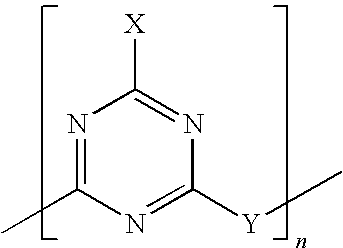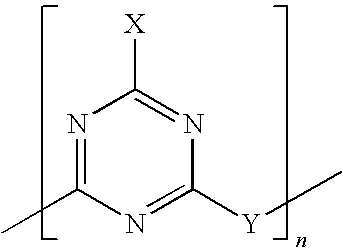Halogen-free flame-proofing agent
a flame-proofing agent and halogen-free technology, applied in the direction of fire-proof paints, etc., can solve the problems of alteration of mechanical and electrical properties of polymers, inability to achieve the effect of flame-retardant, and insufficient protection of flame-retardants in polyolefins, etc., to achieve good flame-retardant action, improve flame-retardant action, and low water solubility
- Summary
- Abstract
- Description
- Claims
- Application Information
AI Technical Summary
Benefits of technology
Problems solved by technology
Method used
Image
Examples
examples
[0051]Some examples are presented below, which include both polymers according to the invention and not according to the invention, and the flame retardants used therein.
[0052]For the examples, test pieces for various tests were prepared in a Brabender plastic kneader. For this, a polymer with no added flame retardant was first melted with stirring. Next, the components A, B, C and / or D were added to the melt in one step as a mixture or consecutively. After a homogenisation phase of 10 to 15 minutes, the plastic material was removed and pressed into plates with thicknesses of 0.8 mm and 1.6 mm by means of a heatable press. The pressed plates were cut into suitable test pieces using a saw and subjected to the tests described below.
[0053]The composition of the different test pieces or comparison test pieces is given in Table 1. The triazine derivative used is a polymer of 2-piperazinylene-4-morpholino-1,3,5-triazine. Further, an uncoated ammonium polyphosphate (FR CROS 484), a melamin...
PUM
| Property | Measurement | Unit |
|---|---|---|
| particle size D50 | aaaaa | aaaaa |
| temperatures | aaaaa | aaaaa |
| particle size D50 | aaaaa | aaaaa |
Abstract
Description
Claims
Application Information
 Login to View More
Login to View More - R&D
- Intellectual Property
- Life Sciences
- Materials
- Tech Scout
- Unparalleled Data Quality
- Higher Quality Content
- 60% Fewer Hallucinations
Browse by: Latest US Patents, China's latest patents, Technical Efficacy Thesaurus, Application Domain, Technology Topic, Popular Technical Reports.
© 2025 PatSnap. All rights reserved.Legal|Privacy policy|Modern Slavery Act Transparency Statement|Sitemap|About US| Contact US: help@patsnap.com


